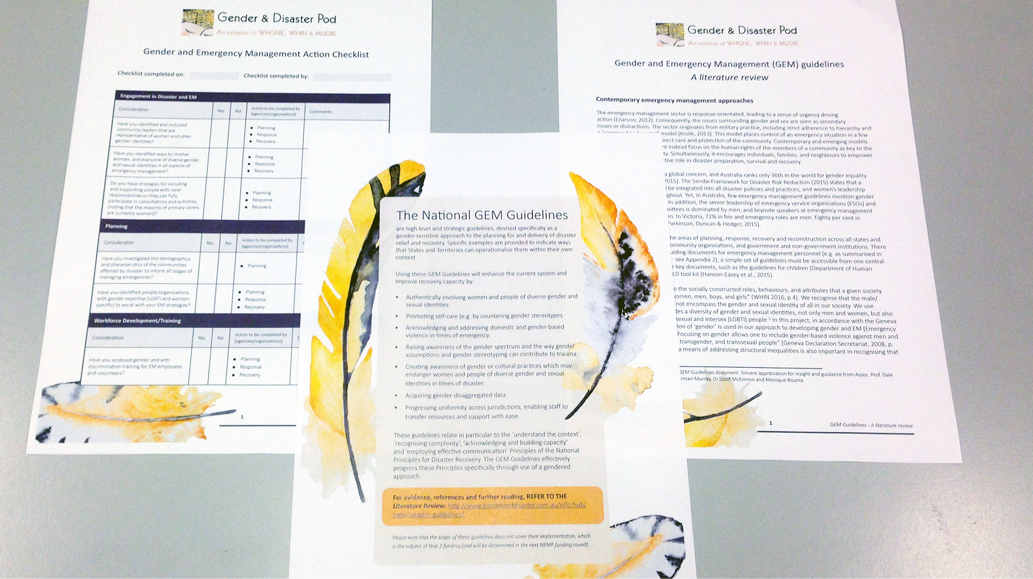
By Debra Parkinson, Alyssa Duncan and Kiri Joyce, Gender and Disaster Pod
Men and women experience emergencies differently and the effects of disaster events on them are different. Issues related to gender are known to compound the already damaging effects of disasters. Emergency plans in Australian states and territories rarely reflect these differential impacts and emergency planning does not yet take a gendered approach. The Attorney-General’s Department recognised this critical gap and funded a project to develop national guidelines for gender and emergency management.
Increased knowledge and integration of gender-focused practices improves the emergency planning process and paves the way for better outcomes in the response and recovery stages. Of primary importance is the health and wellbeing of men and women affected by disaster.
In 2015, the Victorian Department of Health and Human Services facilitated the drafting of the Gender and Emergency Management Guidelines with input from approximately 200 emergency management personnel. This initial draft was based on a Victorian state context and provided a starting point for development of the national guidelines. This was followed in 2016 by the Attorney-General’s Department project to develop national guidelines for gender and emergency management. Collaboration with a further 350 emergency management personnel representing Australian states and territories, resulted in guidelines that reflect practices from across Australia and provide uniformity and clarity.
The national guidelines project was conducted by the Gender and Disaster Pod, an initiative of Women’s Health Goulburn North East, Women’s Health in the North and Monash University Disaster Resilience Initiative. Collaboration with a number of parallel research programs ensured the project was grounded in the latest research. For example, Australian research by Associate Professor Dale Dominey-Howes, Dr Andrew Gorman-Murray and Scott McKinnon with LGBTI (Lesbian, Gay, Bisexual, Trans and Intersex) communities was an important part of the development of the guidelines. In addition, masculinity theorist, Professor Bob Pease, and others within the women’s health sector contributed to the development of the project. An advisory group with representatives from all states and territories, chaired by Professor Frank Archer, guided the project.

The Gender and Emergency Management Guidelines cover three areas of focus with each area encompassing background, principles and actions for consideration. Areas of focus are:
The guidelines include two supporting documents. The Gender and Emergency Management Literature Review is an externally reviewed, comprehensive and up-to-date overview of the significance of gender in emergency management domestically as well as internationally. The Gender and Emergency Management Guidelines Action Checklist offers a quick way for emergency workers to verify that gender awareness is considered and incorporated into emergency planning and management.
The three documents are available online1 along with an external evaluation report. The evaluation report is an independent critique of both the products and the process of the project. The guidelines are also on the United Nations PreventionWeb website at www.preventionweb.net/publications/view/50289.
A conference is planned for later in 2017 to promote the use of the guidelines and inspire the emergency management sector.
For further information contact Debra Parkinson (space@netc.net.au) or Judy Jeffrey (judyjeffrey@activ8.net.au).
A new project aims to identify and learn about the experiences and needs of LGBTI communities in emergencies in Victoria. The findings feed into the development of emergency management policies and procedures that reflect LGBTI-inclusive practice. People can be involved by participating in an online survey.
Victoria’s emergency management sector is currently undertaking a reform agenda that includes embracing diversity in all its forms. The Emergency Management Inclusion Framework2 guides the actions for creating a diverse and inclusive sector and better connecting to Victoria’s diverse communities.
Recent initiatives promoting gender equality in emergency management, and some emergency service organisations, offer cultural awareness training. However, the experiences and needs of LGBTI communities have yet to be fully considered by the emergency management sector. It is important that those involved in management acknowledge that LGBTI communities have differing experiences and specific needs and those needs vary within LGBTI communities according to socio-economic background, gender, ethnicity, age and location.
Dale Dominey-Howes, Andrew Gorman-Murray and Scott McKinnon (2014)3 conducted ground-breaking Australian research on the experiences of LGBTI and other sexual and gender minorities in emergencies in NSW and Queensland. Issues faced by these groups in emergencies include difficulty accessing emergency and support services and resources, harassment and abuse (verbal and physical) and marginalisation or exclusion. This Victoria-based research project includes two online surveys looking for responses from:
Depending on funding, additional interviews may be arranged for those interested.
This research offers an opportunity to inform the emergency management sector about how to improve services and support to LGBTI people. It is only by the contribution of thoughts and experiences by those directly affected that decision-makers will know what needs to change and how it may be changed.
The research project is managed by the Gender and Disaster Pod, in partnership with GLHV@ARCSHS at La Trobe University. It is funded by the Victorian Department of Premier and Cabinet and guided by an advisory group.

LGBTI people’s experiences of disaster and emergency management in Victoria
Conducted by the GAD POD, in collaboration with GLHV@ARCSHS at La Trobe University, and funded by Department of Premier and Cabinet, Victoria.
This survey is the first part of important research. Responses are anonymous. Take part and forward to others who may be interested.
Go to www.genderanddisaster.com.au for details or contact mailto:space@netc.net.au
The GAD Pod is an initiative of Women’s Health Goulburn North East, Women’s Health in the North and Monash University Disaster Resilience Initiative.1 Gender and Emergency Management Guidelines. At: www.genderanddisaster.com.au.
2 Emergency Management Inclusion Framework. At: http://cdn-au.mailsnd.com/83145/2xFwTii0qUPTBnAQ00bM1eDCxAKh7bg-4nvylcjr2uo/2305500.pdf.
3 Dale Dominey-Howes, Andrew Gorman-Murray & Scott McKinnon 2014, Queering disasters: on the need to account for LGBTI experiences in natural disaster contexts, Gender, Place and Culture: A Journal of Feminist Geography, vol. 21, no. 7, pp. 905-918.